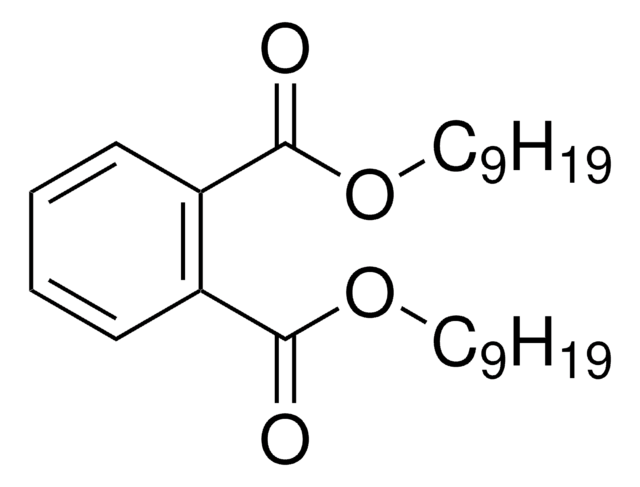36736
Dibutyl phthalate
PESTANAL®, analytical standard
Synonyme(s) :
DBP, Phthalate de n-butyle
About This Item
Produits recommandés
Qualité
analytical standard
Niveau de qualité
Densité de vapeur
9.6 (vs air)
Pression de vapeur
1 mmHg ( 147 °C)
Gamme de produits
PESTANAL®
Pureté
≥98%
Température d'inflammation spontanée
756 °F
Durée de conservation
limited shelf life, expiry date on the label
Limite d'explosivité
0.47 %, 236 °F
Technique(s)
HPLC: suitable
gas chromatography (GC): suitable
Indice de réfraction
n20/D 1.492 (lit.)
Point d'ébullition
340 °C (lit.)
Pf
−35 °C (lit.)
Densité
1.043 g/mL at 25 °C (lit.)
Application(s)
agriculture
cleaning products
cosmetics
environmental
food and beverages
personal care
Format
neat
Chaîne SMILES
CCCCOC(=O)c1ccccc1C(=O)OCCCC
InChI
1S/C16H22O4/c1-3-5-11-19-15(17)13-9-7-8-10-14(13)16(18)20-12-6-4-2/h7-10H,3-6,11-12H2,1-2H3
Clé InChI
DOIRQSBPFJWKBE-UHFFFAOYSA-N
Vous recherchez des produits similaires ? Visite Guide de comparaison des produits
Description générale
Application
Informations légales
Vous ne trouvez pas le bon produit ?
Essayez notre Outil de sélection de produits.
Mention d'avertissement
Danger
Mentions de danger
Conseils de prudence
Classification des risques
Aquatic Acute 1 - Aquatic Chronic 2 - Repr. 1B
Code de la classe de stockage
6.1C - Combustible acute toxic Cat.3 / toxic compounds or compounds which causing chronic effects
Classe de danger pour l'eau (WGK)
WGK 3
Point d'éclair (°F)
367.7 °F - open cup
Point d'éclair (°C)
186.5 °C - open cup
Équipement de protection individuelle
Eyeshields, Gloves, type ABEK (EN14387) respirator filter
Listes réglementaires
Les listes réglementaires sont principalement fournies pour les produits chimiques. Seules des informations limitées peuvent être fournies ici pour les produits non chimiques. L'absence d'indication signifie qu'aucun des composants n'est répertorié. Il incombe à l'utilisateur de s'assurer de l'utilisation sûre et légale du produit.
EU REACH SVHC Candidate List
EU REACH Annex XVII (Restriction List)
EU REACH Annex XIV (Authorisation List)
Faites votre choix parmi les versions les plus récentes :
Déjà en possession de ce produit ?
Retrouvez la documentation relative aux produits que vous avez récemment achetés dans la Bibliothèque de documents.
Les clients ont également consulté
Articles
A sensitive, quantitative, and reproducible SPME-GC/MS procedure was developed by Supelco for the extraction of phthalate esters from oily food matrices, such as the flavored oils included with ramen noodle kits.
Notre équipe de scientifiques dispose d'une expérience dans tous les secteurs de la recherche, notamment en sciences de la vie, science des matériaux, synthèse chimique, chromatographie, analyse et dans de nombreux autres domaines..
Contacter notre Service technique







